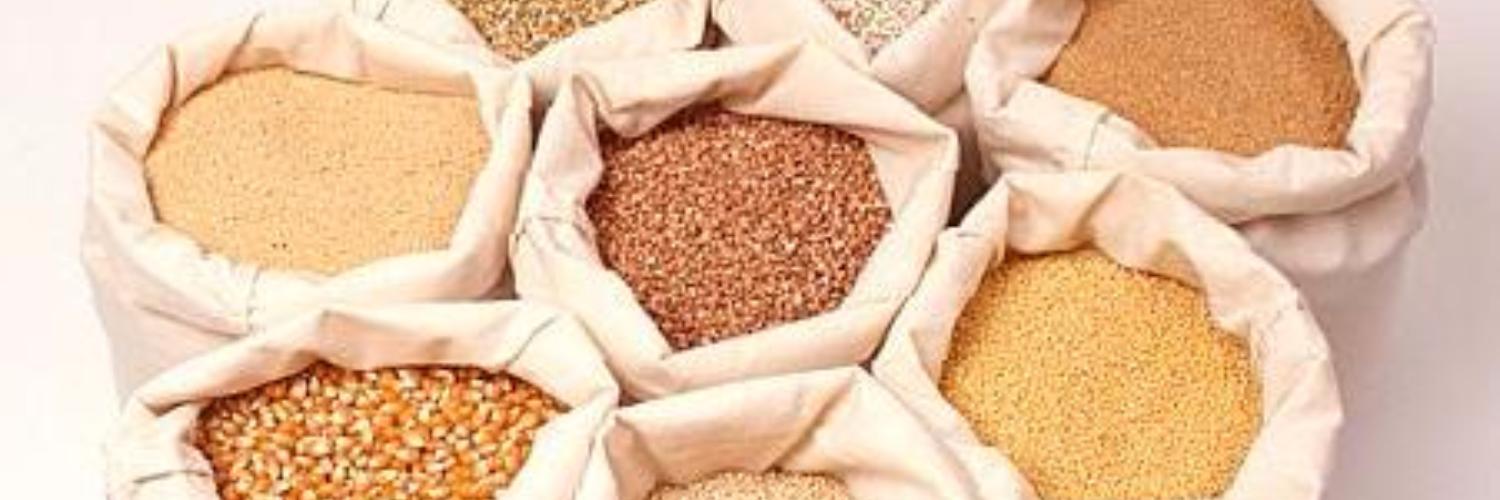An important aspect in the production of feed is the composition of the grain part of the feed, as well as close monitoring of all production steps in order that the nutrients from the feed are subsequently fully absorbed by the animals.
As the particle size of the feed decreases, the surface area of the grain increases and, thus, conditions are created for better interaction with digestive enzymes. This important aspect has been studied for many years, but new data continues to appear on this issue.
Particle size analysis is a study of the distribution of particles of different sizes in feeds of powder forms, closely related to such key processes of feed processing as grinding, fractionation and mixing. In addition, the granulometric composition affects the feed intake and assimilation of feed particles in animals.
Since grain particles have an irregular shape, their size is defined as the diameter of the theoretical sphere, whose properties are similar to those of real particles. Therefore, the distribution process obeys the theoretical laws of particle size distribution. The fineness of grinding the loose forage is determined from the average diameter, and the distribution nonuniformity is the standard deviation.
The particle size of most ingredients used in feed production is reduced both at the feed mill and before they enter the plant.
The crucial advantages of reducing the particle size in the production of feeds are as follows:
- A large surface area contributes to the faster assimilation of nutrients.
- Ingredients are easier to use.
- Ingredients are easier to mix.
- The efficiency of granulation and the quality of granules are increased.
- Feed satisfies the requirements of customers.
At the beginning of the new century, a lot of efforts have been made in Kansas State University (KSU) to study the effect of the size of fodder particles on pigs. It was found that young pigs, in contrast to pigs on growing and fattening, chew food better.
The most potential group of animals for obtaining finer grinding feed are, fattening pigs.
And yet, fine grinding or flattening improves the digestibility of feed regardless of the age of the animal?
Efficiency of feed improves as a result of improved nutrient digestibility. In this case, the average daily weight gain of animals from reducing the size of the feed particles does not suffer. Typically, reducing the particle size reduces feed intake.Nevertheless, the optimum particle size is 500-700 microns.
In pigs that received a grain portion of the feed, ground to a particle size of 500 microns, the efficiency of the feed increased by 6%, in contrast to the pigs that consumed grains with a particle size of 900 microns. On the other hand, when the grain size is reduced (for example, from 700 to 500 microns), the productivity of feed production decreases.
When deciding on the optimum amount of feed particles, a compromise must be found between improving the digestibility of feed and reducing the productivity of the plant. According to the researchers of KSU, the optimal size of the grain particle of the feed is 700 microns, at which the balance of swine productivity and the efficiency of the feed mill is achieved.
Type of grain culture is important
Not all types of grain need to be crushed to the same size. Researchers of grain with a high fiber content, for example, barley, show that grinding grain particles significantly improves the quality of feeding. Scientific evidence suggests that grinding fiber fodder ingredients to about 700 microns increases the nutritional value of the feed, which in turn makes them an attractive substitute for corn.
Wheat grains should be treated in a somewhat different way. Due to the high protein content and the tendency to mealy, there are difficulties in processing wheat. If the grinding is too strong, the feed intake decreases. Therefore, unlike maize and sorghum, wheat grains should have a fraction of a larger size - from 800 to 900 microns.
One of the main disadvantages of fine grinding is the formation of stomach ulcers.The risk of gastric ulcers increases when the grain size becomes less than 500 microns. Another disadvantage of fine grinding is the clogging of feeders and storage bins for storage of feed, as well as dusty food.
Practical research
The KSU studies in the USA showed that two-thirds of the selected feed samples had particles from the recommended range - from 600 to 800 microns. A similar study was conducted at Ohio State University, where scientists determined that the average size of the feed particle was 916 microns using a hammer mill and 720 microns using a conditioner.
It should be noted that great importance was in the fact, where the forages were crushed. The size of the feed particles processed on the farms averaged 881 microns. At the feed mill, the feed particle size averaged 755 microns. With the hammer crushers installed on farms, the particles were of different sizes. As a result of grinding on the farm, particles were obtained with an average size of 1029 microns, at the feed mill - 730 microns.
The economic effect of changing the particle size can be enormous. If the farm uses the full cycle (from farrowing to fattening) with a livestock100 sowsAt an average cost of a ration of 2200 hryvnia per ton, the size of fodder particles will decrease from 1100 to 750 microns, then it will save about 80 thousand hryvnias per year due to the improved digestibility of feed.
Importance of the size of feed particles
Researchers Guillow and Lando from the French society Ucaab gathered an impressive collection of 23 scientific papers and studies to formulate the correlation between the size of feed particles and the nutritional value of the feed.
The general conclusion of their study was as follows: with the increase in the size of the feed particles that the piglets received on growing and fattening by 100 microns, the digestibility of energy in the large intestine is reduced by 0.6 units, and the nitrogen assimilability by 0.8 units.
Of all the technical parameters, only feed conversion is related to piglets with particle size: increasing the particle size by an average of 100 microns resulted in an increase in feed conversion by 0.03 units. This range of changes is unimportant compared to other sources of changes in digestibility or metabolism of feed.
The bird prefers larger particles of feed
TDue to a careful visual observation of the details and specific abilities of the beak to tactile perception, the chicks in the first day of life learn to correlate the nutritional effect with the sensory sensations from the particles of the feed. Selection of particles is fast and accurate.
At the same time, the choice of these or other particles may differ depending on the habits in the sensory perception of the feed. Eating feed depends on the size and hardness of the particles. The determination of the effect of the particle size of the feed in a bird is hampered both by the complexity of the diet and by further processing of the feed, such as granulation or crushing.
The greatest reaction in broiler chickens is the decrease in particle size (from 600 to 500 microns) in the case of a simple ration feed (corn-soybean) in the form of a flour. When feeding with a complex ration in the form of crumbs, reducing the particles to sizes less than 1000 microns was not required. Experiments on hens-hens showed that reducing feed particles to sizes less than 800 microns does not give any advantages.
In his study, Amerah et. Al (2008) found that differences in the grain size distribution of poultry diets (based on corn or wheat) after granulation persisted, especially in the proportions of coarse particles (1 mm and larger). In rations based on corn, coarse grinding improved the weight gain compared to fine grinding, but the same effect was not observed with wheat-based diets.
In both cases, the feeding of broilers with coarse grains resulted in an improvement in the conversion rate of feed compared to feeding with fine-grain feed. In rations based on wheat, coarse grinding improved the true energy metabolic value compared to fine grinding.
In birds that received corn-fed coarse grains, there was an over fulfilment (heaviness) of the muscular stomach. In cases where the coarse grinding feed was based on wheat, such a problem did not arise.In general, the researchers came to the conclusion that the influence of the size of the feed particles on the productivity of the poultry varies depending on the type of grain on which the ration is based.
Exposure to the stomach
Although it is believed that fine grinding increases the surface area of the particle and thereby increases its availability for digestive enzymes, there are also results confirming that coarser grinding with more or less the same particle size increases the productivity of the poultry fed in the form of a mash.
This paradoxical effect can be the result of a positive effect of the size of the feed particles on the development of the muscular stomach. A more developed stomach is usually associated with more active work and, as a result, with greater intestinal mobility and better absorption of nutrients. Although it is believed that finer grinding improves the quality of the pellets, it at the same time significantly increases the energy consumption in the production of feed.
Indian scientists at the Agrarian University of Haryana examined the effects of five different particle sizes (a hammer crusher matrix with a mesh size of 2 to 6 mm) in the broiler feed. The main conclusion is that the feed particles obtained with a 5 mm (868 microns) hammer crusher die matrix were most effectively absorbed by broilers, as their consumption improved feed conversion, reduced energy consumption during grinding and increased weight gain.
Conclusion
The study of the influence of the size of fodder particles is complicated by the influence on the nutritional value of the feed of indirect factors, such as, for example, the stability of the mixture or granulation. Moreover, the choice of the optimum particle size depends on other factors besides nutrients: for example, on the flowability of the feed.
Limited feed intake due to its poor flowability is still a cause for concern. To date, when deciding on the receipt of high-quality fodder, the problem of insufficient technical equipment still "outweigh" the possible benefits of high nutritional standards.
A source:biomedia.rf




